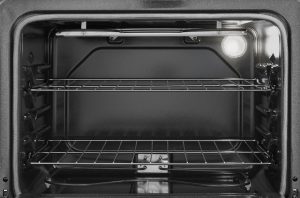The Handle
If you’re the type of person who sanitizes drawer pulls and doorknobs, you won’t need us to tell you about how dirty a range oven handle can get. If not, just think about how many times you have opened up the range when your hands are covered in food. Since you’re likely to be busy preparing a delicious meal, you’re unlikely to stop to wash your hands every time you open up the oven.
Since this is the case, door handles can harbor far more potentially harmful germs compared to other surfaces. So, when you’re wiping down your range after cooking dinner, don’t forget the handles. A simple cloth with antibacterial cleaner should be sufficient; just be sure to reach into any crevices or joints to ensure it is properly sanitized.
The Racks
Range oven racks are exposed to intense amounts of heat, but this doesn’t mean that they are sanitized. Food debris from overflowing casserole dishes or crumbs dropped from baking sheets can all adhere to the racks and encourage bacteria.
So, every month or two, you should give your oven racks a good clean. You can accomplish this by filling your sink with hot, soapy water and allowing the racks to soak for up to an hour. If your racks are too large for your sink, you can do the same thing with an empty bin bag, putting the racks in with hot water and some detergent.
After soaking, you should be able to simply wipe off the grime using a washcloth. However, stubborn debris may require more than one soaking session.
The Grates
Just like the oven racks, if you have a gas cooktop, you will need to give the grates some TLC. Simply lifting them to wipe underneath will not eliminate bacteria. Most range models have grates that can be completely removed and soaked. A good soaking will allow you to wipe off any baked on spills or grime.
Just bear in mind that the hotter the water, the easier it will be to loosen any debris. So, you may need to wear kitchen gloves to keep your hands clean and safe.
Once the grates are clean, you will need to ensure that they are fully dry before you reassemble the stovetop.
Under the Range
Under a range can be a daunting mess. This is the palace where all those food scraps and debris end up. While you may think that you’re a neat cook, you are likely to be surprised at how much food debris can accumulate under your range.
These bits of food can also attract unwanted visitors to your kitchen, so it is crucial that you clean this area properly.
To accomplish this, you will need a thin duster that can reach under the range to wipe up any debris, or you will need to pull out the range all the way, so you can clean underneath and behind the appliance.
If you’re struggling to get your range spotless or it has other faults, you can rely on your local home appliance repair technician to help. An experienced technician can assess your range to determine any underlying problems and help you get back to cooking.
